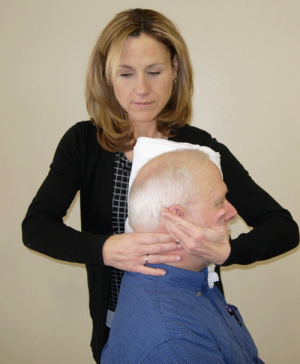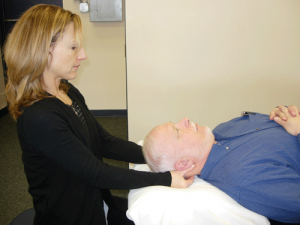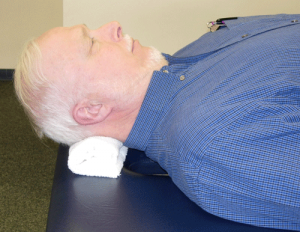
Physical Therapy for Headaches
2 CommentsPhysical therapy is often utilized in the comprehensive treatment for headache sufferers. For certain types of headaches, physical therapy has proven to be successful in decreasing and/or resolving the intensity and frequency of symptoms, improving an individual’s function and mobility, and improving an individual’s quality of life. A common type of headache seen in clinical practice that responds well to physical therapy is cervicogenic headache
What is a Cervicogenic Headache
A Cervicogenic headache stems from the structures in the cervical spine (neck) and radiates into other areas, such as the back of the head, over the top of the head, and/or on the side of the head. This type of headache may occur gradually or occur as a result of an injury.
If you would like to see an Athletico physical therapist about headache treatment, please use the button below to schedule a complimentary injury screen at a clinic near you.
Click to Schedule a Free Injury Screen
An individual suffering from a cervicogenic headache may report an increase in symptoms with movement of the head or neck and a decreased ability to do so. Symptoms may increase with prolonged positions or postures, such as sitting for extended periods of time on the computer.
Other symptoms associated with cervicogenic headache include:
- Neck pain
- Muscle tenderness
- Tenderness over the joints in the neck
- Shoulder/arm pain on the same side of the headache
- Weakness
- Possible dizziness, nausea, and lightheadedness
Cervicogenic headache and associated symptoms are typically the result of stiff joints in the neck, more specifically the upper portion of the neck, soft tissue tightness and/or trigger points, and possibly nerve irritation.
Physical therapy is commonly prescribed for individuals who suffer from cervicogenic headaches. The physical therapist will do a comprehensive musculoskeletal exam to determine which structures are contributing to the symptoms.
The exam may include assessment of:
- Range of motion of the head/neck
- Joint movement
- Musculature tightness, tenderness, and trigger points posture
- Strength and endurance of the deep neck muscles
- Posture
The physical therapist will also include other appropriate tests and measures.
A physical therapist will then design a specific treatment plan based on the results of the examination. Manual therapy techniques will most likely be preformed in order to decrease pain and increase the movement of the head/neck. Figure 1 demonstrates a joint mobilization technique for a stiff joint in the upper cervical spine. The goal is to decrease the stiffness of the joint to increase the range of motion of the head/neck. Figure 2 demonstrates a general manual therapy technique to decrease stress on the head and neck and promote pain relief.

Figure 1

Figure 2
In addition to manual therapy techniques, physical therapy treatment will include the performance of exercises to increase the strength and endurance of the deep neck flexor muscles. Figure 3 demonstrates a craniocervical flexion exercise whereby the individual is instructed to gently nod his head, by bringing his chin towards his throat. He is also instructed to relax his shoulders to avoid compensatory patterns of other muscles. Additional exercises are performed in physical therapy to promote strength and endurance of the neck muscles and upper back muscles.

Figure 3
The individual is instructed to gently nod his head by bringing his chin towards his throat. This position may be held for up to 10 seconds for 10 repetitions.
Other physical therapy interventions used to address cervicogenic headache include and are not limited to: soft tissue massage, cardiovascular exercise, education on posture and body mechanics, stretching, and pain relieving modalities. Individuals should expect to attend physical therapy sessions 2-3 times per week for 3 to 6 weeks. With appropriate treatment from a physical therapist who specializes in headache interventions, one can expect a decrease in cervicogenic headache signs and symptoms.
The Athletico blog is an educational resource written by Athletico employees. Athletico bloggers are licensed professionals who abide by the code of ethics outlined by their respective professional associations. The content published in blog posts represents the opinion of the individual author based on their expertise and experience. The content provided in this blog is for informational purposes only, does not constitute medical advice and should not be relied on for making personal health decisions.
References:
- Biondi, D Cervicogenic Headache:A Review of Diagnostic and Treatment Strategies. April 2005;105 (4).
- Chaibi, A et al. Manual therapies for cervicogenic headache: a systematic review. J Headache Pain. 2012; 13: 351-359.
- Fernandez de las Penas, C, et al. Clinical reasoning for manual therapy management for cervicogenic headache. 2004; 22 (1): 45-51.
- Farmer, P et al. An investigation of Cervical spine posture in cervicogenic headache. Physical Therapy. February 2015. 95 (2): 212-222.
- Hall, T et al. Clinical Evaluation of Cervicogenic Headache: A Clinical Perspective.Man Manip Ther. 2008; 16(2): 73–80.
- Headache Classification Subcommittee of the International Headache Society. The International Classification of Headache Disorders: 3rd edition (beta version). 2013. Cephalalgia 2013; 33 (9): 629-808.
- Jull, G et al. Trial of management of cervicognic Headahce. Pine 2002 27 (17):1835-1843.
- Winkel D. Differential Diagnosis of the Spine: Nonoperative Orthopedic Medicine and Manual Therapy. PRO-ED, Inc; 1996.

2 Comments
Eileen
Excellent article! And an excellent therapist too – well written / Am I surprised? Nope! Great job.
Denise Terman
I live in Ingham County in Michigan. I am being treated for cervicogenic migraines severe. I have been referred to physical therapy for treatment of this. Is there such a specialized therapist near me?